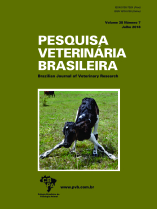 |
|
|
|
Year 2018 - Volume 38, Number 7
|

|
Sporotrichosis in domestic felines (Felis catus domesticus) in Campos dos Goytacazes/RJ, Brazil, 38(7):1438-1443
|
ABSTRACT.- Almeida A.J., Reis N.F., Lourenço C.S., Costa N.Q., Bernardino M.L.A. & Vieira‑da‑Motta O. 2018. [Sporotrichosis in domestic felines (Felis catus domesticus) in Campos dos Goytacazes/RJ, Brazil.] Esporotricose em felinos domésticos (Felis catus domesticus) em Campos dos Goytacazes, RJ. Pesquisa Veterinária Brasileira 38(7):1438-1443. Laboratório de Clínica e Cirurgia Animal, Universidade Estadual do Norte Fluminense Darcy Ribeiro, Av. Alberto Lamego 2000, Parque Califórnia, Campos dos Goytacazes, RJ 28013-602, Brazil. E-mail: jardim@uenf.br
Sporotrichosis is a subcutaneous mycosis of subacute to chronic evolution, caused by the dimorphic and geophilic fungus Sporothrix schenckii. The zoonotic transmission has been highlighted, with domestic cats having an important epidemiological role in the disease. This research aimed to diagnose cases of sporotrichosis in domestic cats treated in the city of Campos dos Goytacazes/RJ, as well as to correlate the positive cases with the clinical signs observed in them, as well as risk factors such as sex, castrated animals or not, among other characteristics. One hundred domestic felines were used, with skin lesions suspected of sporotrichosis, which underwent a thorough clinical evaluation and completion of individual files. The lesions were then selected for material collection in sterile swabs and subsequent laboratory analysis, through cytology and fungal culture. Of the 100 animals analyzed, 66 (66%) were positive for Sporothrix spp., Being 46 (69.6%) uncastrated males, 15 (22.7%) uncastrated females, 4 (6.06%) females castrated and 1 (1.5%) castrated male, 89.3% of whom had access to the street. Concerning the lesion topography and clinical status of the animals, 43 (65.2%) had focal lesions and 23 (34.8%) disseminated lesions, where 21 (31.8%) died or were submitted to euthanasia at the option of tutor. With the results of the exams, it was possible to adequately prescribe the therapeutic protocol and follow up of 40 animals (60.6%), and in the cases of the cats referred (7.5%), the respective veterinarian was informed of the respective diagnosis so that this To choose their therapeutic behavior. |
| |
|
|
| |
|
 |